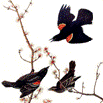Wildlife Damage Management, Internet Center for
Document Type
Article
Date of this Version
November 1976
Abstract
An accurate economic analysis of pest species, such as birds depredating agricultural systems, would entail a thorough understanding of the species1 ecological relationships with all components of their environment. Understanding behavioral patterns (e.g., seasonal territorialism and gregariousness, reproductive characteristics, and annual food habits), population dynamics (e.g., natality, mortality, and sex ratios), and environmental pressures (e.g., carrying capacity and interspecific competition) would only begin to provide a base for a valid evaluation. No single parameter could integrate the complex interactions which affect agricultural production. However, evaluation of one such parameter, food habits analysis, could provide enough useful information for estimating one aspect of economic pressure, the direct crop losses resulting from avian agricultural depredation. This study was an economic evaluation of the Redwing, Starling, and Cowbird, in relation to agricultural production and crop yield in north-central Ohio during the late summer and early fall of 1974. The evaluation was limited to projecting direct dollar losses based solely on the species1 food habits. No attempt was made to measure actual damage, as was done by Ogden (1969) and others (Anon., 1974; Anon., 1975; Winters, 1973). Further, findings from this three-month study could not be extrapolated to the entire year, since food habits shift according to changes in seasonal food availability.


